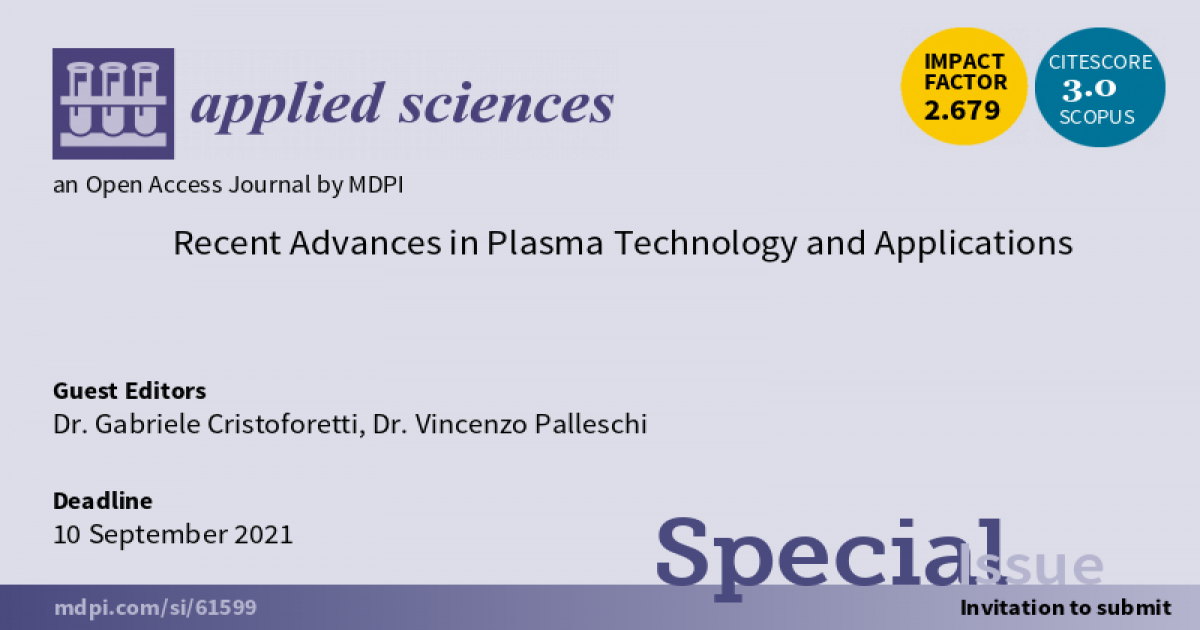Recent Advances in Plasma Technology and Applications
A special issue of Applied Sciences (ISSN 2076-3417). This special issue belongs to the section "Applied Physics General".
Deadline for manuscript submissions: closed (10 September 2021) | Viewed by 33847

Special Issue Editors
Interests: laser–plasma interaction; plasma spectroscopy; inertial confinement fusion
Special Issue Information
Plasma physics is often associated with the investigation of matter in the conditions needed to build a fusion reactor, which would be a green and unlimited power source for the future. However, many objects that we use in everyday life involve the use of plasmas, and new plasma-based applications are regularly being proposed.
Often, these objects make use of plasmas obtained by electrical discharge or laser ablation, and are much colder than typical multi-keV, fully ionized fusion plasmas; these plasmas, usually called low-temperature plasmas, are only partially ionized and typically have a temperature of a few eV. Applications of low-temperature plasmas include fluorescent Ar or Ne lamps, plasma treatment in the manufacturing industry to clean or enhance the adhesion of surfaces, plasma etching and coating deposition in electronics, material processing such as cutting and welding, techniques for the sterilization of tools or cauterization of wounds in medicine and rocket propulsion in the aerospace industry.
Other promising applications relying on laser–plasma interactions are for example the determination of material composition by analyzing its laser-induced plasma emission (LIBS technique), the synthesis of nanoparticles by pulsed laser ablation in liquid or in gas, the acceleration of particle bunches to relativistic energy for hadronic therapy in cancer patients and the realization of plasma-based X-ray or g-ray sources.
All the above topics, a field of research which is certainly rich and fascinating, are relevant to the present Special Issue, which aims to give an overview of recent advances in the field.
We welcome both original research papers and review papers in this field, believing that this issue can be an excellent opportunity for researchers in plasma physics to present new experimental results, propose new ideas for applications and discuss recent advances.
Dr. Gabriele Cristoforetti
Prof. Vincenzo Palleschi
Manuscript Submission Information
Manuscripts should be submitted online at www.mdpi.com by registering and logging in to this website. Once you are registered, click here to go to the submission form. Manuscripts can be submitted until the deadline. All submissions that pass pre-check are peer-reviewed. Accepted papers will be published continuously in the journal (as soon as accepted) and will be listed together on the special issue website. Research articles, review articles as well as short communications are invited. For planned papers, a title and short abstract (about 250 words) can be sent to the Editorial Office for assessment.
Submitted manuscripts should not have been published previously, nor be under consideration for publication elsewhere (except conference proceedings papers). All manuscripts are thoroughly refereed through a single-blind peer-review process. A guide for authors and other relevant information for submission of manuscripts is available on the Instructions for Authors page. Applied Sciences is an international peer-reviewed open access semimonthly journal published by MDPI.
Please visit the Instructions for Authors page before submitting a manuscript. The Article Processing Charge (APC) for publication in this open access journal is 2400 CHF (Swiss Francs). Submitted papers should be well formatted and use good English. Authors may use MDPI's English editing service prior to publication or during author revisions.
Benefits of Publishing in a Special Issue
- Ease of navigation: Grouping papers by topic helps scholars navigate broad scope journals more efficiently.
- Greater discoverability: Special Issues support the reach and impact of scientific research. Articles in Special Issues are more discoverable and cited more frequently.
- Expansion of research network: Special Issues facilitate connections among authors, fostering scientific collaborations.
- External promotion: Articles in Special Issues are often promoted through the journal's social media, increasing their visibility.
- Reprint: MDPI Books provides the opportunity to republish successful Special Issues in book format, both online and in print.
Further information on MDPI's Special Issue policies can be found here.






